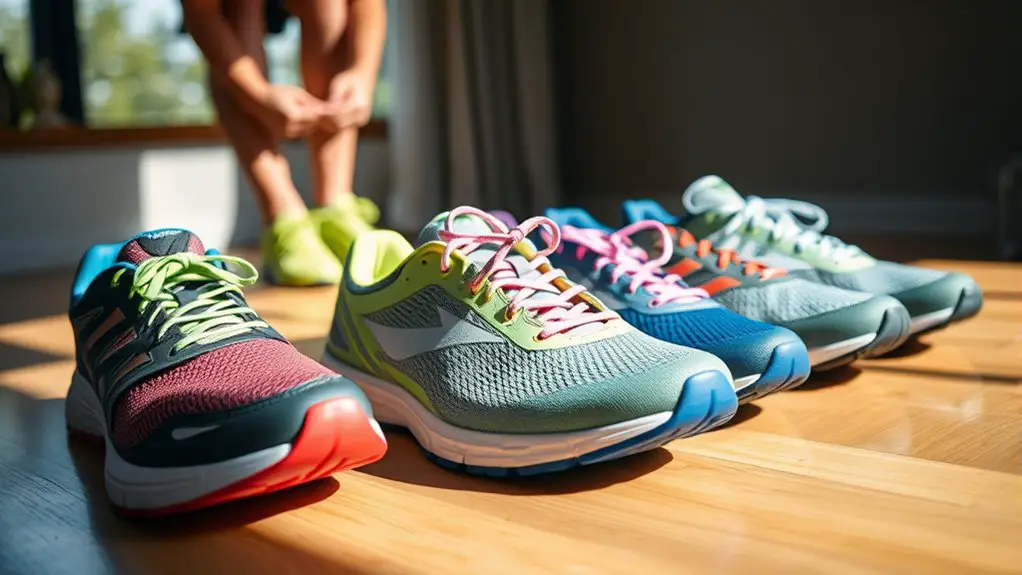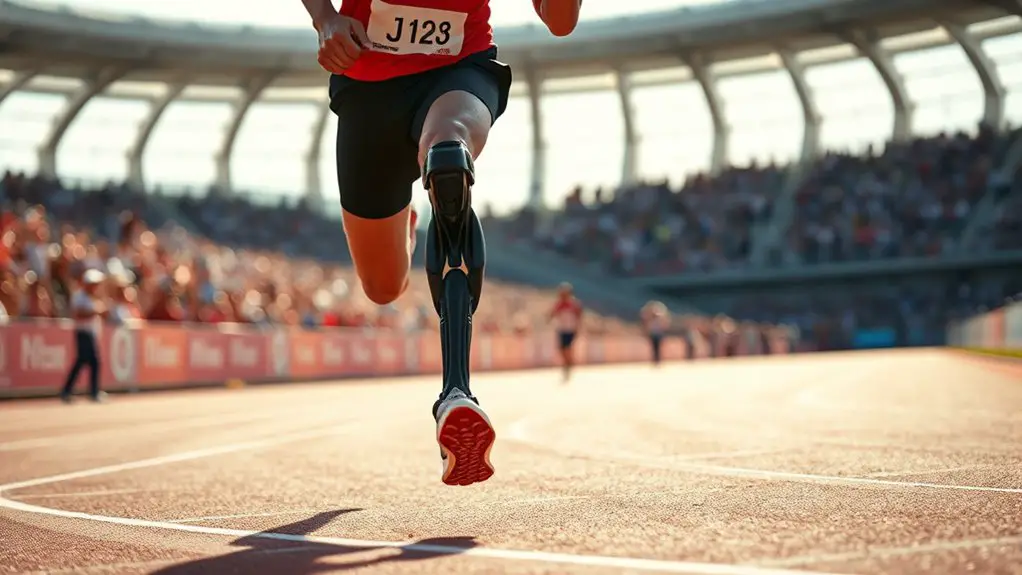To choose the right running shoes, start by understanding your foot type—flat, neutral, or high-arched. Next, assess your gait to see if you overpronate, underpronate, or have a neutral stride. Consider the terrain you'll be running on, like road or trail, as this affects shoe features. When trying on shoes, make sure they fit well and feel comfortable. Finally, keep an eye on wear and tear to know when it's time for a replacement, and there's more to explore.
Understanding Your Foot Type
How well do you know your foot type? Understanding it is essential for choosing the right running shoes that let you feel free and confident on the road. There are three main types: flat, neutral, and high-arched. If you've got flat feet, your arches might collapse, leading to a need for stability shoes. Neutral arches provide a balanced stride, so you can opt for cushioned shoes. High-arched feet mean you require extra cushioning to absorb impact. Knowing your foot type not only enhances your comfort but also helps prevent injuries. When you choose shoes that align with your foot's unique shape, you're setting yourself up for a more liberating and enjoyable running experience. Embrace your foot type, and let it guide your shoe choices!
Assessing Your Gait
Once you understand your foot type, the next step is to assess your gait. This will help you choose running shoes that enhance your natural stride and provide the freedom you crave on the road or trail.
Understanding your foot type is just the beginning; assessing your gait is essential for finding the perfect running shoes.
To assess your gait, consider these key factors:
- Pronation: Determine whether you overpronate, underpronate, or have a neutral gait.
- Foot Strike: Notice how your foot lands—heel, midfoot, or forefoot can influence shoe choice.
- Stride Length: Observe if you have a short, efficient stride or a longer, more forceful one.
Considering Your Running Terrain
As you choose running shoes, it's important to evaluate the terrain where you'll be running, since different surfaces require specific features for ideal performance. Knowing whether you'll be hitting the road, trail, or track can guide your selection.
| Terrain Type | Recommended Shoe Features |
|---|---|
| Road | Lightweight, cushioning, support |
| Trail | Grippy outsole, stability, protection |
| Track | Flat, minimalistic, lightweight |
| Treadmill | Durable, breathable, flexible |
| Mixed Terrain | Versatile, adaptable, all-purpose |
Trying on Shoes Properly
After narrowing down your choices based on terrain, the next step is trying on shoes properly to guarantee the best fit and comfort. Finding the right pair is vital for your freedom on the run. Here's what to keep in mind:
- Wear the right socks: Bring your favorite running socks to make sure of a true fit.
- Test them out: Walk or jog around the store to feel how they respond to your movements.
- Check for space: Verify there's a thumb's width between your longest toe and the shoe's front, allowing room for foot expansion.
Knowing When to Replace Your Shoes
Knowing when to replace your running shoes is essential for maintaining your performance and preventing injuries. Generally, you should consider swapping them out every 300 to 500 miles, but this varies based on your running style and terrain. Keep an eye out for signs of wear like flattened cushioning, visible creases, or loss of grip. If you notice discomfort or aches that weren't there before, it's time to reassess your shoes. Trust your instincts; they know when your shoes are holding you back. Remember, running's about freedom, and worn-out shoes can hinder that experience. So, listen to your body, and don't hesitate to invest in a fresh pair when it's time. Your feet will thank you!
Frequently Asked Questions
How Much Should I Spend on Running Shoes?
You shouldn't feel pressured to overspend. A good pair of running shoes typically ranges from $100 to $150, but it's wise to find ones that fit your budget while still offering comfort and support.
Can I Use Running Shoes for Other Sports?
Yes, you can use running shoes for other sports, but they might not provide the support or grip you need. It's best to evaluate the specific requirements of each activity before making a choice.
Do Running Shoes Have a Lifespan?
Running shoes age like fine wine, but they won't last forever. You'll find their lifespan's about 300 to 500 miles. Once they start feeling flat or worn, it's time to set your feet free with new ones.
What Is the Best Brand for Running Shoes?
When it comes to finding the best brand for running shoes, trust your instincts. Brands like Nike, Brooks, and Asics often lead the pack, but you'll want to try different pairs to find your perfect fit.
How Often Should I Replace My Running Shoes?
Like the wings of a bird, your running shoes need renewal. You should replace them every 300 to 500 miles, ensuring your stride remains light and free, unhindered by wear, ready for new adventures.




